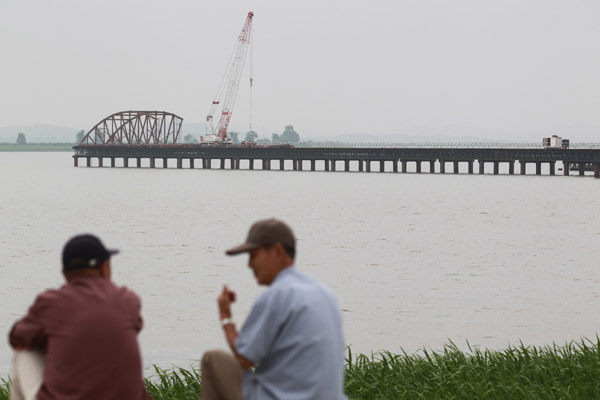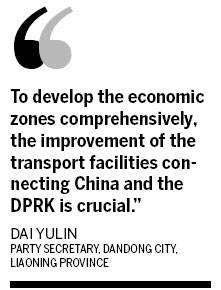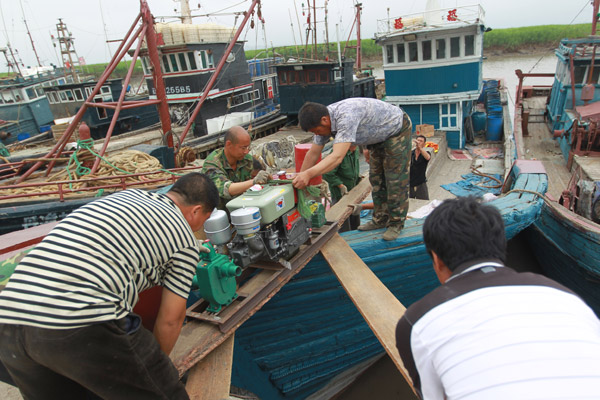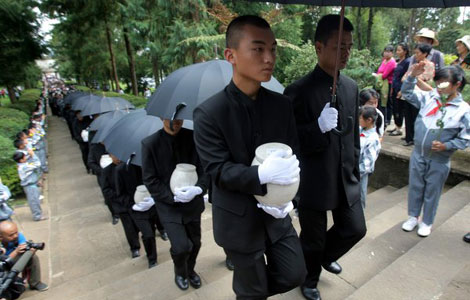Changes emerging as DPRK opens up
Updated: 2011-09-14 08:11
By Bao Chang (China Daily)
|
|||||||||||
Looking across the Yalu River at the Democratic People's Republic of Korea (DPRK), the country on the opposite bank seems mysterious and remote, with pale lights glimmering from a row of houses, vying for attention with the rising stars as night falls.
 |
|
A new bridge linking China and the DPRK under construction, seen from the Chinese side. The two countries are improving facilities connecting them to develop economic and trade exchanges. [Photo/ China Daily] |
On the Chinese side of the river, the streets are awash with color from the neon lights flickering in Dandong's new district and presenting a very different nocturnal scene.
"The DPRK looks like China during the 1970s. I haven't seen many changes there over the past decades," said Li Jian, an elderly man who has lived in Dandong, a Chinese city that borders the DPRK, for more than 50 years.
However, an advertising board written in both Chinese and Korean, which has been standing on DPRK's Hwanggumpyong Island since June, says change is afoot and an opening up to the rest of the world is under way.
It was in that month that China and the DPRK agreed to establish three special zones to deepen economic and trade ties between the two countries and to help promote economic relations between the so-called Hermit Kingdom and the rest of the world.
The agreement followed a visit to China by the DPRK's leader Kim Jong-il in May.
Emerging as if from hibernation, the DPRK is warming to Chinese-style economic reforms.
"The area will help boost the DPRK's foreign direct investment, turning the zones into a hot investment destination," said Dai Yulin, Party secretary of Dandong.

The first big investment opportunities are likely to come in the field of mineral mining as the infant market opens up. The DPRK's iron ore deposits are in the spotlight as steel makers expand capacity to meet the growing demand in the Asian and African markets, according to China Sunny & Forecasting Information Consultant Ltd (S&F), a Beijing-based market research company.
The amount of exploitable iron ore in the DPRK will reach 10 million tons annually by 2015, up from 6 million tons this year, an increase prompted by an expansion in investment by overseas companies, according to estimates from S&F.
The British company Global Steel Holdings Ltd has been negotiating with the DPRK government for a stake in the Musan iron ore mines in the country's North Hamgyong province, estimated to have reserves of more than 5 billion metric tons.
Pramod Mittal, a brother of the steel tycoon Lakshmi Mittal and the chairman of Global Steel, a closely held company of the Mittal family, visited Pyongyang last year, reportedly to talk to senior government officials and begin the groundwork necessary for gaining a share of the Musan reserves.
Mittal denied the claims. However, according to the Economic Times, he did add: "Our visit to North Korea is to further business interests. We are not looking for a stake in Musan." Meanwhile, companies from the Republic of Korea (ROK), including Pohang Iron and Steel Co Ltd (POSCO) and Korea Resources Corporation, are also stepping up efforts to get a slice of the action in the DPRK.
Currently, there are some 200 mineral deposits in the DPRK, including rare earths, with reserves of 6 billion tons, with a potential value of $6.6 trillion, according to S&F.
Iron ore exploration is still in its infancy in the DPRK. The total mined iron ore was about 50 million tons between 1998 and 2008, or 8.3 percent of the entire reserve.
"As the DPRK opens up, more and more investors from all over the world, including Chinese enterprises, will enter the market. Most of them will be intent on investing in resources projects," said a permanent delegate with the family name Zhou at the Pyongyang office of China Aerospace Beijing Changfeng Co Ltd.
 |
|
Workers loading a new engine on to a boat used for Sino-DPRK trade on the Yalu River in Dandong, Liaoning province. [Photo/ China Daily] |
Meanwhile, recent years have seen several Chinese companies, including Sinosteel Corp, China Minerals Corp and Shougang Tonggang Group, enter the iron ore market in the DPRK.
Having entered the DPRK in 2006, through cooperation with a local steel factory, the Shougang Tonggang Group now imports iron ore worth 14 million yuan ($2.2 million) from the country annually.
China imported 1.81 million tons of iron ore from the DPRK in 2009, a slight decline compared with a year earlier.
However, S&F predicts that by 2015, iron ore exports from the DPRK to China will reach at least 4.2 million tons, double the figure this year.
Currently, between 25 and 35 percent of the DPRK's total explored iron ore deposits are exported to China each year.
"Chinese enterprises have obvious advantages when investing in the DPRK's mineral industry because we are not only geographically close to the market but also have ample financial support and the advanced technology that the DPRK needs," said a researcher at the Chinese Academy of International Trade and Economic Cooperation who declined to be identified.
While China is planning to increase investment in minerals mining in the DPRK, the latter is striving to learn about high technology from its neighbor.
He Liangliang, a news commentator at Hong Kong-based Phoenix Satellite Television, said that during his visit to China, Kim showed great interest in high technology.
"The DPRK intends to attract some high-tech Chinese enterprises to establish subsidiaries on Hwanggumpyong Island, from which the country will be able to learn how to improve the innovative capabilities of its domestic companies," commented a Chinese government official in Dandong who also declined to be identified.
The undeveloped island, situated adjacent to Dandong, will be developed as a special economic zone.
The unidentified official added that discussions are under way about a specific development plan for the island, including an amusement park, a free-trade area of 20,000 square meters and an import-export processing area.
A second economic zone will be located at the DPRK border city of Rajin-Sonbong (also known as Rason) near the Tumen River.
Bloomberg has reported that ground was broken on the initial stages of the project in June. Meanwhile, another undeveloped island called Wihwa, which is also close to Dandong, will be the site of the third zone.
"To develop the economic zones comprehensively, the improvement of the transport facilities connecting China and the DPRK is crucial," Dai of Dandong said.
Construction of a second road bridge linking the two countries has already started in Dandong and is scheduled for completion within the next three years.
The 6-kilometer, two-way bridge is expected to cost about 1.7 billion yuan. It will be paid for by China.
"The first bridge to be built over the Yalu River in more than half a century will be a major link between the two countries," Dai said.
The existing bridge was built in the 1930s and cannot cope with the increased volume of traffic that has resulted from the rising level of commercial exchange between the two countries, said Lu Chao, a researcher at the Liaoning Academy of Social Sciences.
Lu said the new bridge, 10 km downstream from the existing structure, will be linked to the Dongbiandao railway, which in turn will be connected to the Trans-Siberian Railway.
"It will be part of a railway network connecting the major countries in Northeast Asia," he said.
"Dandong is aiming to break through a lack of internal economic motivation and foreign investment as investors come in waves," Dai said.
He added that companies involved in sectors such as marine engineering, special steel, colored steel and automotive audio are expected to settle on Hwanggumpyong Island and Dandong city.
To boost trade with the DPRK, a tax-free zone of 10 sq km will also be set up in Dandong city, which has been included in the key development area of Liaoning Coastal Economic Zone, comprising an area of 192.86 sq km.
In Hunchun city, Jilin province, to which the special economic zone Rajin-Sonbong is very close, a maintenance project on the original bridge linking China and the DPRK is ongoing and will be completed this year.
"We are stepping up efforts to establish the infrastructure and transportation network, aiming to develop Hunchun and Rajin-Sonbong into a trade hub for several Northeast Asian countries," said Wang Xiaoping, head of the Tumen River Area Cooperation Division of the Jilin provincial government.
"Trade and investment in Rajin-Sonbong and Hunchun are at the heart of our ambitions to develop the Tumen River area," Wang said.
ROK's POSCO, the world's third largest steel maker, and SK Group, the fourth-largest conglomerate in the ROK, have both invested in Hunchun city.
The hinterland surrounding the Tumen River is one of the world's last great land-based resource frontiers, with reserves of oil, timber, coal, minerals and an abundance of farmland and fresh water.
"The booming bilateral trade between China and other Northeast Asian countries will help to promote trade within the community," Wang added.
According to China's General Administration of Customs, the value of direct exports to China from the DPRK last year was $1.2 billion, a 51 percent increase year-on-year, attributed to China's robust demand for iron ore, coal and copper.
At present, the DPRK mainly imports grain and oil from China. In 2010, China's exports to its peninsula neighbor reached $2.3 billion, an increase of 21 percent from a year earlier.
"Investors have seen vast business opportunities through the country's announcement about the development of the DPRK into a thriving nation by 2012," Wang said of the ambitious leader's plans.
Hot Topics
Organ transplant bonds mother and son
Editor's Picks

|

|

|

|

|

|







